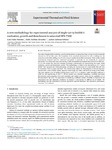A New Methodology for Experimental Analysis of Single-Cavity Bubble’s Nucleation, Growth and Detachment in Saturated HFE-7100

Use this link to cite
http://hdl.handle.net/2183/39959
Except where otherwise noted, this item's license is described as CC BY license http://creativecommons.org/licenses/by/4.0/
Collections
- Investigación (EPEF) [590]
Metadata
Show full item recordTitle
A New Methodology for Experimental Analysis of Single-Cavity Bubble’s Nucleation, Growth and Detachment in Saturated HFE-7100Date
2024-12Citation
I. Talão Martins, P. Fariñas Alvariño, L. Cabezas-Gómez, A new methodology for experimental analysis of single-cavity bubble’s nucleation, growth and detachment in saturated HFE-7100, Experimental Thermal and Fluid Science 159 (2024) 111272. https://doi.org/10.1016/j.expthermflusci.2024.111272.
Abstract
[Abstract] The study of single bubble nucleation, growth and detachment processes has being carried out with remarkable relevance in the last fifty years. The complexity of the associated phenomena are still a challenge for the researchers in the field, yielding a lot of works trying to explain the enrolled mechanisms. These studies include experimental, numerical and even theoretical approaches. In particular but not exclusively for numerical approaches, it is of essential importance having a solid and detailed experimental description of the full event. It is in this context that this work emerges, proposing a methodology for characterizing the single bubble nucleation, growth and detachment process. This methodology is based in the determination of a “typical bubble” that represents the whole phenomena, providing the reconstruction of a main bubble life-cycle with its uncertainty (both in space and time). This reconstruction allows the determination of several important characteristics, such as bubble volume, apparent contact angle, dry radius, and the forces acting on the bubble. This work analyzes a set of bubbles growing from a cavity of
diameter, under saturated conditions at 0,583 bar and superheating of 25,8 °C. All the outputs were obtained considering a carefully uncertainty determination and propagation from both systematic and random sources, which are not negligible as it is demonstrated in this work. The importance of considering a sufficient number of bubbles to characterize the phenomenon was also addressed, considering an analysis of uncertainties for different set of bubbles. The methodology was also confronted to previous approaches reported elsewhere, that ensured its performance, robustness, and validation.
Keywords
Experimental bubble growth
Image processing
Ensemble averaging
Image processing
Ensemble averaging
Editor version
Rights
CC BY license http://creativecommons.org/licenses/by/4.0/
ISSN
1879-2286






